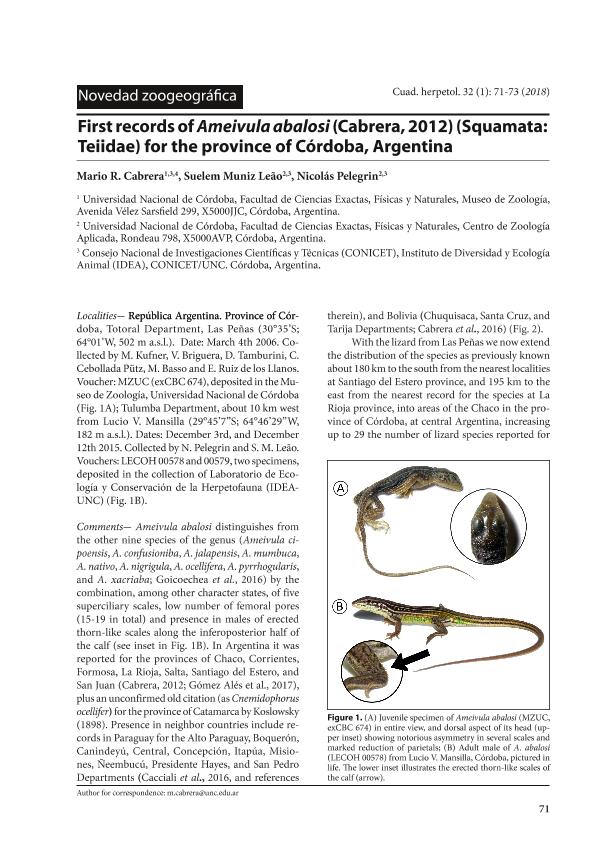Artículo
First records of Ameivula abalosi (Cabrera, 2012) (Squamata: Teiidae) for the province of Córdoba, Argentina
Fecha de publicación:
05/2018
Editorial:
Asociacion Herpetológica Argentina
Revista:
CUADERNOS DE HERPETOLOGIA
ISSN:
0326-551X
e-ISSN:
1852-5768
Idioma:
Inglés
Tipo de recurso:
Artículo publicado
Clasificación temática:
Resumen
Localities ̶ República Argentina. Province of Córdoba, Totoral Department, Las Peñas (30º35´S, 64º01´W, 502 m a.s.l.). Date: March 4th 2006. Collected by M. Kufner, V. Briguera, D. Tamburini, C. Cebollada Pütz, M. Basso and E. Ruiz de los Llanos. Voucher: MZUC (exCBC 674), deposited in the Museo de Zoología, Universidad Nacional de Córdoba (Fig. 1).República Argentina. Province of Córdoba, Tulumba Department, about 10 km west from Lucio V. Mansilla (29°45´7"S, 64°46´29"W, 182 m a.s.l.). Dates: December 3rd, and December 12th 2015. Collected by N. Pelegrin and S. M. Leão. Vouchers: LECOH 00578 and 00579), two specimens, deposited in the collection of Laboratorio de Ecología y Conservación de la Herpetofauna (IDEA-UNC) (Fig. 2). Comments ̶ Ameivula abalosi distinguishes from the other 13 species of the A. ocellifera species group by the combination, among other character states, of five superciliary scales, low number of femoral pores (15-19 in total) and presence in males of erected thorn-like scales along the inferoposterior half of the calf (see detail in Fig. 2). In Argentina it was reported for the provinces of Corrientes, El Chaco, Formosa, La Rioja, Salta, Santiago del Estero, and San Juan (Cabrera, 2012; Gómez Alés et al., 2017), plus an unconfirmed old citation (as Cnemidophorus ocellifer) for Catamarca province by Koslowsky (1898). Presence in neighbor countries include records in Paraguay for the Alto Paraguay, Boquerón, Canindeyú, Central, Concepción, Itapúa, Misiones, Ñeembucú, Presidente Hayes, and San Pedro Departments (Cacciali et al., 2016, and references therein), and Bolivia (Chuquisaca, Santa Cruz, and Tarija Departments; Cabrera et al., 2016). In this report we extend the distribution of the species about 180 km to the south and 195 km to the east from the nearest localities previously known (Cabrera, 2012), into new areas of the Chaco in the province of Córdoba, at central Argentina (Fig. 3), increasing up to 30 the number of lizard species reported for this province by Cabrera (2015). MZUC (exCBC 674) is a juvenile (SVL= 40.7 mm) that fell in a trap arrangement placed where a soybean culture parcel limited with Chaco forest (Ruiz de los Llanos, pers. comm.) during field collects to evaluate influence of agricultural expansion on vertebrate diversity (Cebollada Pütz et al., 2012). LECOH 00578 and 00579 are two adult male specimens captured by pitfall trapping in a Chaco forest area next to Salinas Grandes, at northwestern Córdoba. Predominant vegetation there was spiny shrubs and cacti, typical of the transition between the Arid Chaco forest and the salt plain of Salinas Grandes.All localities where A. abalosi has been found belong either to the Semiarid, Arid, or Humid Chaco subregions sensu Naumann (2006). To the present, no individuals of this species have been confirmed for the Mountain Chaco (Chaco Serrano). Tio Vallejo and Miranda (1984) cited Cnemidophorus ocellifer for Tanti (MACN 10247), Cruz Chica (MACN 29625), and Cruz Grande (MACN 21446), three mountainous villages of Córdoba province. However, revised by one of us (MRC) in 2002, the specimens MACN 10247 (two individuals) and MACN 29625 correspond to Contomastix serrana, undescribed by 1984. The MACN 21446 could not be found in the collection.
Palabras clave:
GEOGRAPHICAL DISTRIBUTION
,
LIZARD
,
CHACO ECOREGION
,
CORDOBA
Archivos asociados
Licencia
Identificadores
Colecciones
Articulos(IDEA)
Articulos de INSTITUTO DE DIVERSIDAD Y ECOLOGIA ANIMAL
Articulos de INSTITUTO DE DIVERSIDAD Y ECOLOGIA ANIMAL
Citación
Cabrera, Mario Roberto; Muniz Leao, Suelem; Pelegrin, Nicolas; First records of Ameivula abalosi (Cabrera, 2012) (Squamata: Teiidae) for the province of Córdoba, Argentina; Asociacion Herpetológica Argentina; CUADERNOS DE HERPETOLOGIA; 32; 1; 5-2018; 71-73
Compartir
Altmétricas




